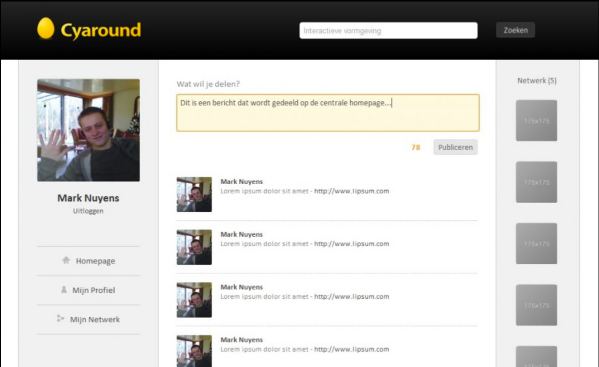Cyaround.com
In 2010, I created a social network for designers and developers to connect and called it called Cyaround.com, a phrase i used a lot back then in instant messaging. Its logo, a small egg, symbolized a project in progress. Despite my limited experience, primarily gained through a few college classes, I managed to develop a first version using PHP and MySQL, along with HTML & CSS. This initial iteration included essential features like a message board, avatar support, profile pages, the ability to connect with other users, and a search function.
The goal was to provide a platform for my classmates, designers, and developers to connect and share insights, while also showcasing their skills and expertise. Cyaround was kind of a unique blend of LinkedIn, Dribbble, and Facebook, combining elements of professional networking, design inspiration, and social interaction. It's worth noting that back then, both LinkedIn and Facebook were not as developed as they are today. I take pride in the fact that my concept was original in terms of design, features, and overall simplicity.
The primary motivation behind the project was to create a network I could personally utilize in the future, connecting with people based on their skills and collaborating on projects together.
 The homepage (message board) along with its main interface.
The homepage (message board) along with its main interface.While Cyaround didn't survive beyond two years, reflecting on the past fills me with admiration for my youthful optimism and spirit. Balancing college responsibilities while working on improving my skills through school projects was quite a challenge. Nonetheless, the network experienced a level of popularity that I found remarkable at the time, with around 50 users at its peak. The most significant lesson I learned from this venture was that I could build something valuable by connecting people and enabling them to share information.
In a way, this realization echoes the somewhat cliche sentiments of Mark Zuckerberg. Maybe it’s in the name, who knows. Another valuable lesson was understanding that Cyaround was built on a few simple PHP scripts. Its success stemmed from its simplicity, a principle that still holds true for user interfaces today. In conclusion, the process of creating a personalized website to connect with others, without having to rely on other social networks, was immensely fulfilling.
This social network has remained on my mind over the years, actively serving as a reminder of the joy in building applications based on my own ideas, essentially creating a universe of virtually endless possibilities. That freedom, to pursue such endeavors, is something I continue to aspire to today.